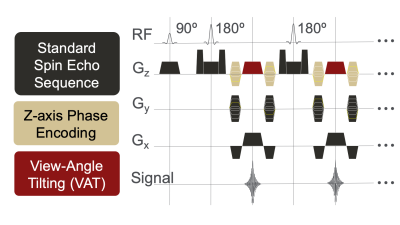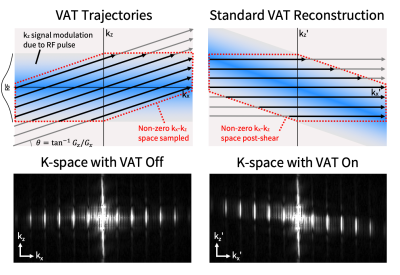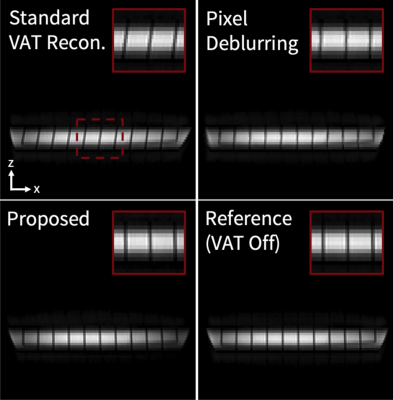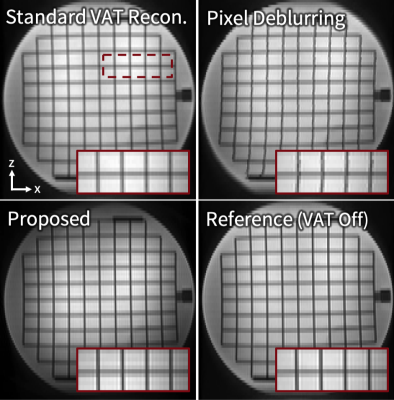3406
Mitigation of Blurring due to View-Angle Tilting in Multispectral Imaging1Radiology, Stanford University, Stanford, CA, United States, 2Electrical Engineering, Stanford University, Stanford, CA, United States, 3Bioengineering, Stanford University, Stanford, CA, United States
Synopsis
Imaging near metal is challenging due to severe metal-induced field inhomogeneities. Multispectral imaging sequences employ view-angle tilting (VAT) to correct in-plane distortions due to nearby metal at the expense of blurring the entire image. We exploit the additional phase-encoding dimension acquired in multispectral imaging in order to reduce the VAT-induced blur. The method primarily consists of regridding k-space measurements to avoid the VAT-induced shear. Results on a grid phantom demonstrate the ability of this method to reduce readout blur. This work highlights an important limitation of VAT and demonstrates strategies for mitigating this effect.
Introduction
MRI is the clinical standard for assessing soft tissue abnormalities in musculoskeletal applications, including cases near metal implants. However MRI near metal is quite challenging primarily due to severe metal-induced field inhomogeneities that can result in significant spatial misregistration errors. Multispectral imaging (MSI) techniques such as SEMAC1 and MAVRIC-SL2 all employ view-angle tilting3 (VAT) in order to correct these spatial misregistration errors in-plane at the cost of some blurring4,5. In addition to VAT, MSI methods phase-encode the excited slice (or spectral “bin”) data to resolve through-plane distortions (Figure 1). The aim of this work is to mitigate VAT blurring in on-resonance portions of the image which have no need for the VAT correction.VAT consists of simply replaying the slice-select gradient during readout (Figure 1)3. This limits the bandwidth of spins during readout to that of the excitation1,6. This is very helpful near metal where frequency shifts can be many times larger than the excitation bandwidth.
The VAT gradient shears the k-space trajectories (Figure 2). As this is ignored in reconstruction, a readout-direction blur results across the entire image. This blurring typically necessitates the use of a conventional 2D spin-echo scan for evaluation away from metal, which ideally would be avoided.
Standard VAT reconstruction provides a very coarse shear correction by bulk shifting each bin/slice (or equivalently demodulating by the excitation frequency). Koch et al2 proposed a pixel deblurring method which distorts each excited bin/slice based on a field map estimate. We propose a simple k-space gridding approach in order to correct for the shear-induced blurring and remove the need for a second 2D spin-echo scan.
Methods
We mitigated the shear-induced blurring from VAT by regridding each spectral bin acquisition in k-space. This was done by linearly interpolating the acquired k-space onto a 2x oversampled Cartesian grid. We then applied an anti-aliasing filter to the gridded k-space and subsampled back to the original resolution, equivalent to cropping in the image domain after gridding to a fine grid.The proposed method was compared against the standard VAT reconstruction with and without the pixel deblurring method2. We collected data by running the same MAVRIC-SL sequence twice, once with the VAT gradient on and once with it off. The various VAT deblurring approaches were applied to the VAT-on case and compared against the VAT-off case.
A metal-free grid phantom was used in order to highlight the adverse effects of VAT in on-resonant regions away from metal. The y dimension is not shown because it is phase-encoded and unaffected by VAT and metal distortions1.
All images were acquired on a 3T GE Signa Premier. Acquisition parameters: voxel resolution 1.2x1.2x2.4 mm, matrix size 256x256x80, readout bandwidth +/-125kHz, RF bandwidth 1 kHz, nominal slice thickness 7.4 mm (Full-width, half-max). Slice-select and readout gradient amplitudes were 3.2 mT/m and 19.4 mT/m respectively, resulting in a VAT angle of 9.3°.
Results
Figure 3 demonstrates a single-bin reconstruction of “VAT-on” data using each of the 3 different reconstruction methods. The pixel-deblurring and regridding approaches both corrected the shear, but the regridding approach resulted in less readout blur. Figure 4 shows the sum-of-squares combination of all bins for each method. For standard VAT reconstruction, the residual shear of each individual bin resulted in significant blurring upon combination. In both figures the proposed regridding approach resulted in less readout blur as compared with the pixel-deblurring method. Vertical grid lines appear smoother in z and sharper in x.Discussion
The proposed method and pixel deblurring both rely on regridding the data, but in different domains and at different stages of the reconstruction. Pixel deblurring accuracy could be limited by imperfect field estimation as well as the limited resolution of a discrete correction. On the other hand, the proposed k-space regridding is computed from a precisely-known VAT angle and affords a continuous correction in the measurement domain.VAT is a general-purpose technique for reducing in-plane distortions caused by off-resonance, but the proposed deblurring method has more limited scope. Sufficient coverage of the kx-kz plane is needed in order to accurately regrid k-space. MSI is an excellent match for this technique due to the additional phase-encoding dimension.
One irreversible effect of the VAT gradient is that the shear results in incomplete k-space coverage (top row of Figure 2). This effect appeared to be insignificant for our chosen acquisition parameters, but in other cases it may be worthwhile to devise a modified sampling scheme for better coverage of k-space.
We focused our analysis on metal-free images in order to isolate the readout blur effect from the distortion-correcting ability of VAT. Future research will investigate how best to combine the regridding output of on-resonance regions with off-resonance regions closer to metal.
Conclusion
This work highlights shear-induced blurring as an important limitation of VAT and demonstrates the relative performance of a few strategies for mitigating this effect. The proposed regridding method leverages the kz sampling already used in MSI approaches in order to reduce readout blur in on-resonance portions of an image. This improves the efficiency of the scan by deriving a complementary higher resolution on-resonance image from the data without additional scan time.Acknowledgements
Research support provided by R01 EB017739 and GE Healthcare.References
1. Lu W, Pauly KB, Gold GE, Pauly JM, Hargreaves BA. SEMAC: Slice encoding for metal artifact correction in MRI. Magnetic Resonance in Medicine. 2009;62(1):66-76. doi:10.1002/mrm.21967
2. Koch KM, Brau AC, Chen W, et al. Imaging near metal with a MAVRIC-SEMAC hybrid. Magnetic Resonance in Medicine. 2011;65(1):71-82. doi:10.1002/mrm.22523
3. Cho ZH, Kim DJ, Kim YK. Total inhomogeneity correction including chemical shifts and susceptibility by view angle tilting. Medical Physics. 1988;15(1):7-11. doi:10.1118/1.596162
4. Butts K, Pauly JM, Gold GE. Reduction of blurring in view angle tilting MRI. Magnetic Resonance in Medicine. 2005;53(2):418-424. doi:10.1002/mrm.20375
5. Jung K-J, Moon C-H. Effect of slice angle on inhomogeneity artifact and its correction in slice-selective MR imaging. Concepts in Magnetic Resonance Part A. 2009;34A(4):238-248. doi:10.1002/cmr.a.20143
6. Olsen RV, Munk PL, Lee MJ, et al. Metal Artifact Reduction Sequence: Early Clinical Applications. RadioGraphics. 2000;20(3):699-712. doi:10.1148/radiographics.20.3.g00ma10699
Figures



